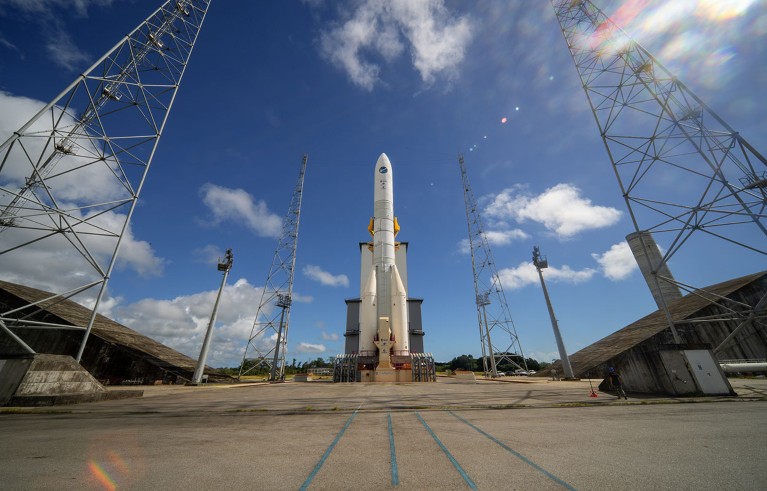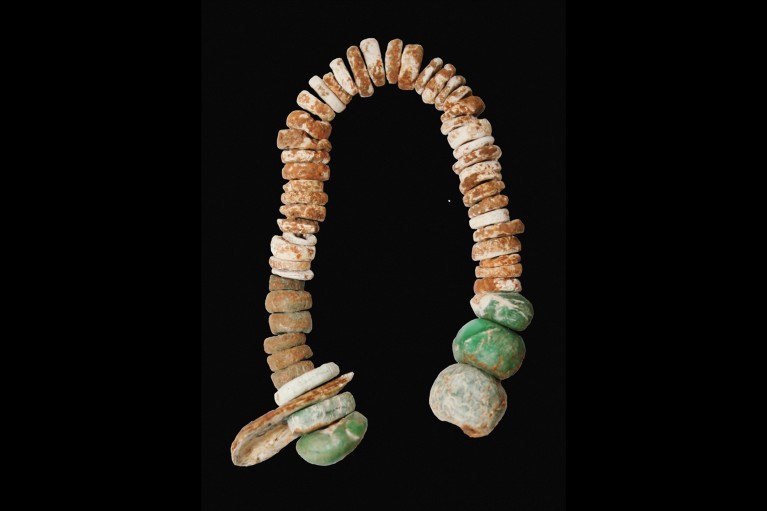Hello Nature readers, would you like to get this Briefing in your inbox free every day? Sign up here.

The Ariane 6 rocket on the launch pad at Europe’s spaceport in French Guiana.Credit: M. Pédoussaut/ESA
After years of delays, the heavy-lift launcher Ariane 6 is scheduled for an inaugural flight next week. Some European missions have been grounded since Ariane 5, which sent the James Webb Space Telescope into orbit, was retired last year. “You don’t want to depend on anybody, and that’s why all spacefaring nations want their own access to space,” says Lucia Linares from the European Space Agency. Ariane 6 has already been booked for around 30 launches, including for commercial customers.
The enigmatic ancient humans known as Denisovans hunted marmots, eagles and even hyenas to thrive high on the Tibetan plateau for well over 100,000 years. “It’s at high altitude. It’s cold. It’s not a nice place to be as a hominin,” says archaeologist Frido Welker, one of the researchers who analysed thousands of animal bone fragments from a cave in northern China.
For the first time, individual brain cells have been seen to respond to the essence of words. Researchers recorded the activity of around 300 neurons each in 10 people who had electrodes implanted in their brains to manage epilepsy. Only a few neurons fired for each word when the participants listened to short sentences. Words that fell into similar categories — actions, food or animals — as well as words that could be associated — such as ‘duck’ and ‘egg’ — triggered similar brain activity. To an extent, the researchers could determine what people were hearing by watching their neurons fire.
Researchers in the United Kingdom have published a voluntary code of practice for scientists working with human-embryo models. It prohibits implanting the embryo models into the uterus of a living person or other animal but doesn’t set a fixed time limit on how long models can be grown in the lab, as some other countries have proposed. “The guidelines and recommendations are sensible, careful, with a look to the future,” says stem-cell biologist Jacob Hanna.
Reference: SCBEM Code of Practice
Features & opinion
Researchers are hunting for new ways to strip salt from water as the world’s freshwaters are becoming more salty and industries are producing more briny waste. Current methods are often energy-intensive or create problematic waste. Some scientists are using electricity to pull salt from water through specialized membranes. Others are working with a solvent that traps water — but not salt. With battery-makers clamouring for lithium-rich salts, future desalination companies could even turn a profit selling salts while offering clean water as a free byproduct.
In May, South Korea’s Supreme Court upheld a decision to sentence a prominent academic to two years in prison for sharing data of national importance with researchers in China. The ruling shows that scientists must be cautious and diligent in protecting data as borders dissipate in the digital age, argues law scholar WooJung Jon. Researchers should receive data security and intellectual property training, he says, and universities need to protect sensitive data and foster responsible international collaboration.
Loss functions provide a mathematical measure of wrongness: they tell researchers how well their artificial-intelligence (AI) algorithms are working. There are dozens of off-the-shelf functions. But choosing the wrong one, or handling it badly, can create AI systems that blatantly contradict human observations or obscure experiments’ central results. Programming libraries such as PyTorch and scikit-learn allow scientists to easily swap and trial functions. A growing number of scientists are creating their own loss functions. “If you’re in a situation where you believe that there are probably errors or problems with your data … then it’s probably a good idea to consider using a loss function that’s not so standard,” says machine-learning researcher Jonathan Wilton.
Image of the week

Shells were coated with resin to make these imitation amber beads, which were found in a tomb in what is now Portugal. Credit: C. P. Odriozola et al./J. Archaeol. Sci.
This Stone Age jewellery is fake. Ancient artisans probably wanted to mimic the feel and look of highly prized amber by coating shells in bone glue, pine resin, beeswax and a red-orange pigment. The beads, which were found in a tomb in what is now Portugal, are the oldest example of a human-made composite material. (Nature | 3 min read, Nature paywall)
Reference: Journal of Archaeological Science paper
Congrats to Max the cat, who, at just six years old, has just earned himself an honorary doctorate in litter-ature at Vermont State University (an institution that doesn’t usually award doctorates). Max’s academic achievements, detailed on his directory page, include sitting outside campus buildings, climbing all over students and asking for pets from everyone.
Please tell me what other unusual academic achievements deserve a doctorate (alongside any feedback on this newsletter) by sending an email to briefing@nature.com.
Thanks for reading,
Katrina Krämer, associate editor, Nature Briefing
With contributions by Flora Graham, Gemma Conroy and Sarah Tomlin
Want more? Sign up to our other free Nature Briefing newsletters:
• Nature Briefing: Microbiology — the most abundant living entities on our planet — microorganisms — and the role they play in health, the environment and food systems.
• Nature Briefing: Anthropocene — climate change, biodiversity, sustainability and geoengineering
• Nature Briefing: AI & Robotics — 100% written by humans, of course
• Nature Briefing: Cancer — a weekly newsletter written with cancer researchers in mind
• Nature Briefing: Translational Research — covers biotechnology, drug discovery and pharma





